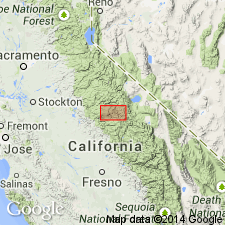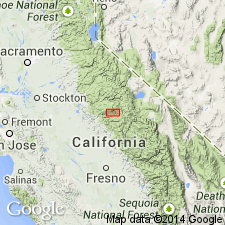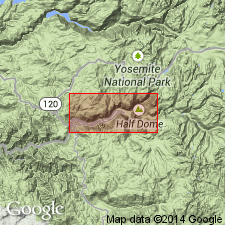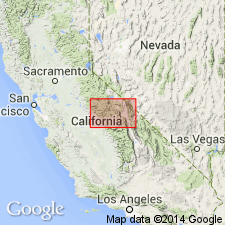
- Usage in publication:
-
- Leaning Tower quartz monzonite*
- Modifications:
-
- Named
- Dominant lithology:
-
- Quartz monzonite
- AAPG geologic province:
-
- Sierra Nevada province
Summary:
Named Leaning Tower quartz monzonite. Forms part of slopes of Leaning Tower. Typical rock type exposed in one small intrusive body, in mouth of gulch of Bridalveil Creek, though more porphyritic facies occurs near Big Oak Flat Road near Taft Point. On weathered surface deeply decayed and rusty. Fresh fractures are dull-gray color and moderately fine texture. Contains biotite and hornblende in roundish clusters. Intruded by Bridalveil granite. [Age is probably Cretaceous(?)].
Type locality not designated. Named from Leaning Tower in Yosemite National Park [Lat. 37 deg. 42 min. 46 sec. N., Long. 119 deg. 38 min. 56 sec. W., Yosemite 15-min quadrangle, Mariposa Co., CA].
Source: Modified from GNU records (USGS DDS-6; Menlo GNULEX).

- Usage in publication:
-
- Leaning Tower Quartz Monzonite*
- Modifications:
-
- Age modified
- AAPG geologic province:
-
- Sierra Nevada province
Summary:
Described as having color medium-gray; texture medium-grained, granular. Contains biotite and less hornblende; these are largely in clusters about 10 mm in diameter. Listed as older than Bridalveil Granite in "rocks of minor intrusive bodies". Age is Cretaceous.
Source: GNU records (USGS DDS-6; Menlo GNULEX).

- Usage in publication:
-
- Leaning Tower Granodiorite*
- Modifications:
-
- Redescribed
- AAPG geologic province:
-
- Sierra Nevada province
Summary:
"The map [Yosemite] itself remains unchanged but its explanation has been modified to reflect current nomenclature.." Name Leaning Tower Quartz Monzonite changed to Leaning Tower Granodiorite. Assigned Cretaceous age.
Source: GNU records (USGS DDS-6; Menlo GNULEX).

- Usage in publication:
-
- Leaning Tower Granite*
- Modifications:
-
- Redescribed
- Age modified
- Revised
- AAPG geologic province:
-
- Sierra Nevada province
Summary:
Included within intrusive suite of Buena Vista Crest. Name changed to Leaning Tower Granite to reflect current IUGS classification (citing Streckeisen, 1973). Age is mid Cretaceous.
Source: GNU records (USGS DDS-6; Menlo GNULEX).
For more information, please contact Nancy Stamm, Geologic Names Committee Secretary.
Asterisk (*) indicates published by U.S. Geological Survey authors.
"No current usage" (†) implies that a name has been abandoned or has fallen into disuse. Former usage and, if known, replacement name given in parentheses ( ).
Slash (/) indicates name conflicts with nomenclatural guidelines (CSN, 1933; ACSN, 1961, 1970; NACSN, 1983, 2005, 2021). May be explained within brackets ([ ]).

